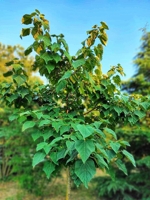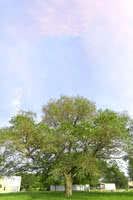Mon-Fri 9am - 5pm Mountain time
Empress Tree vs Discovery Japanese Elm
Paulownia tomentosa
Ulmus davidiana var. japonica Discovery
NOT AVAILABLE THIS SEASON - MIGHT RETURN
The Empress Tree is a fast growing, ornamental shade tree. It has purple, fragrant flowers that are quite attractive. The flowers emerge before the leaves in early spring. The leaves of this tree can grow very large, up to 30 cm long.
As one of the fastest growing trees in the world, this tree has been given considerable attention for carbon sequestration projects. It drops many seeds which can make it invasive in warmer climates. Please do some research and plant the right tree in the right place.
The Empress tree’s genus name comes from Princess Paulowna, daughter of Tsar Paul I of Russia.
Discovery Japanese Elm is great for anyone who doesn't have a lot of time to maintain their trees as it doesn't drop many seeds. It has beautiful dark green foliage and is resistant to Dutch Elm Disease. This elm is similar in shape to the American Elm but is roughly 30% smaller. Instead of having an irregular and broad-shaped crown as other Japanese Elms do, the Discovery Japenses Elm has symmetrical branching, an upright growth form, and develops a classic vase-like crown.

